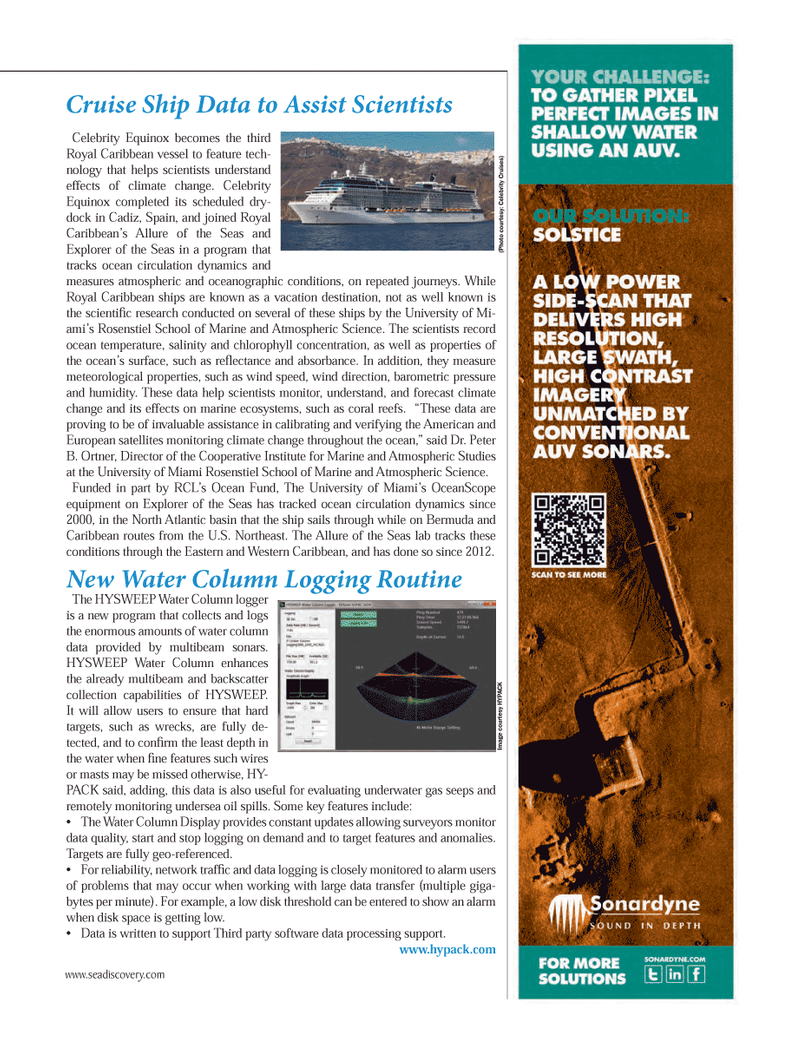
Page 45: of Marine Technology Magazine (June 2014)
Hydrographic Survey
Read this page in Pdf, Flash or Html5 edition of June 2014 Marine Technology Magazine
Celebrity Equinox becomes the third
Royal Caribbean vessel to feature tech- nology that helps scientists understand effects of climate change. Celebrity
Equinox completed its scheduled dry- dock in Cadiz, Spain, and joined Royal
Caribbean’s Allure of the Seas and
Explorer of the Seas in a program that tracks ocean circulation dynamics and measures atmospheric and oceanographic conditions, on repeated journeys. While
Royal Caribbean ships are known as a vacation destination, not as well known is the scientifi c research conducted on several of these ships by the University of Mi- ami’s Rosenstiel School of Marine and Atmospheric Science. The scientists record ocean temperature, salinity and chlorophyll concentration, as well as properties of the ocean’s surface, such as refl ectance and absorbance. In addition, they measure meteorological properties, such as wind speed, wind direction, barometric pressure and humidity. These data help scientists monitor, understand, and forecast climate change and its effects on marine ecosystems, such as coral reefs. “These data are proving to be of invaluable assistance in calibrating and verifying the American and
European satellites monitoring climate change throughout the ocean,” said Dr. Peter
B. Ortner, Director of the Cooperative Institute for Marine and Atmospheric Studies at the University of Miami Rosenstiel School of Marine and Atmospheric Science.
Funded in part by RCL’s Ocean Fund, The University of Miami’s OceanScope equipment on Explorer of the Seas has tracked ocean circulation dynamics since 2000, in the North Atlantic basin that the ship sails through while on Bermuda and
Caribbean routes from the U.S. Northeast. The Allure of the Seas lab tracks these conditions through the Eastern and Western Caribbean, and has done so since 2012.
New Water Column Logging Routine
The HYSWEEP Water Column logger is a new program that collects and logs the enormous amounts of water column data provided by multibeam sonars.
HYSWEEP Water Column enhances the already multibeam and backscatter collection capabilities of HYSWEEP.
It will allow users to ensure that hard targets, such as wrecks, are fully de- tected, and to confi rm the least depth in the water when fi ne features such wires or masts may be missed otherwise, HY-
PACK said, adding, this data is also useful for evaluating underwater gas seeps and remotely monitoring undersea oil spills. Some key features include: The Water Column Display provides constant updates allowing surveyors monitor data quality, start and stop logging on demand and to target features and anomalies.
Targets are fully geo-referenced. For reliability, network traffi c and data logging is closely monitored to alarm users of problems that may occur when working with large data transfer (multiple giga- bytes per minute). For example, a low disk threshold can be entered to show an alarm when disk space is getting low. Data is written to support Third party software data processing support. www.hypack.com
Image cour tesy HYP
A
CK (Photo cour tesy: Celebrity Cruises)
Cruise Ship Data to Assist Scientists www.seadiscovery.com
MTR #5 (34-49).indd 45 6/9/2014 4:25:35 PM

 44
44

 46
46
